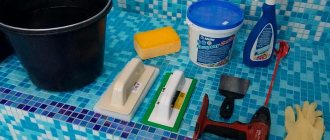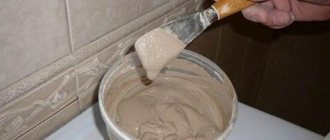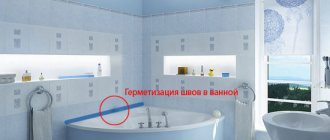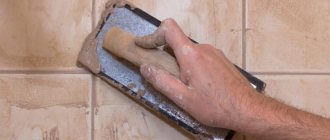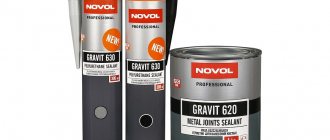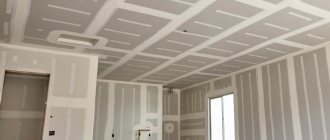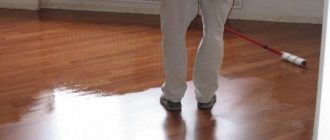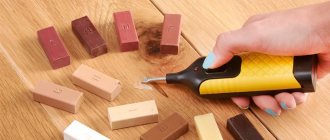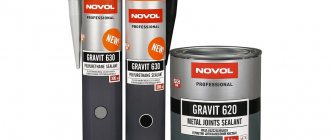Adhesive sealant for seams, gray
CEMMIX Adhesive-sealant for seams is a one-component polyurethane sealant for sealing various seams, junctions of steps and walls, entry of pipes and ventilation systems and rigid-elastic gluing of various materials.
More details
Sealing seams with curb tape
Sealing the joints between the bathtub and the wall with self-adhesive polyethylene-based border tape is a simple and economical option. It is easy to glue the tape at a 90° angle, since it has a fold line in the middle. The thickness of the tape should be selected depending on the thickness of the seam, taking into account the fact that it should be glued with an allowance of 2 cm.
The seam surfaces are cleaned and degreased. During the gluing process, the protective layer of paper is gradually removed from the tape in small sections and pressed tightly with the adhesive side to the seam surfaces. The kit should include a plastic spatula - it is used to form a right angle.
In order to ensure durable adhesion of the curb tape, you can additionally apply a universal adhesive-sealant, for example, SikaFlex®-11FC+ (i-Cure), to the adhesive part. The tape will fully adhere within 24 hours.
Adhesive sealant for seams, brown
CEMMIX Adhesive-sealant for seams is a one-component polyurethane sealant for sealing various seams, junctions of steps and walls, entry of pipes and ventilation systems and rigid-elastic gluing of various materials.
More details
Especially often, mold occurs in various seams, which is understandable, since the flow of air there is difficult.
Therefore, reliable sealing of seams is also the prevention of mold in the apartment.
On straight sections of walls or floors lined with ceramic or other tiles, special cement-based grout mixtures (they can be colored) or epoxy compounds are used to fill the tile joints when there is strong chemical aggression or large mechanical loads.
Elastic sealing materials are used at seams between dissimilar materials or in places of possible deformations of the building (internal corners of rooms, half-wall junctions).
The seams between the bathtub and the tiles, all joints: the sink to the wall, the toilet to the floor, are usually sealed, and all openings for communications are also sealed.
However, recently craftsmen have also been using sealants for gluing tiles, as well as for filling tile seams.
Silicone sealants for bathroom
When deciding which sealant is best to choose for processing the joint between the wall and the bathroom, many craftsmen prefer silicone. It cannot be called cheap, but it is durable, fits perfectly on any surface, withstands large temperature changes and exhibits minimal shrinkage when drying (up to 2%).
At the same time, silicone retains its elasticity for many years, which allows it to be used even in places where some deformation is observed.
Silicone sealants are divided into acidic and neutral. Acidic ones (another name is acetic) are cheaper than neutral ones, but have a limited scope of application. They cannot be applied to metal products, because during the vulcanization process such compositions lead to corrosion of the metal.
Neutral silicone sealants are more expensive, but they can be used on both acrylic and metal surfaces.
Is it possible to use sealant for gluing tiles and grouting joints, and what is it for?
Tiles are the best choice for finishing bathroom walls and floors. For the floor, tiles made of more durable porcelain stoneware are also sometimes used.
However, in any case, this tile must be glued with something and the seams between the tiles must be filled.
Important!
The width of the joints between the tiles depends on various factors: the size and shape of the tiles, the designer’s intentions, and technical capabilities. Typically, wider joints are left for large or shaped tiles. Standard size tiles (up to 60 cm on a side) are usually laid with joints of about 6 mm wide. Seams narrower than 3 mm can be difficult to fill with grout, so they are rarely used; Seams wider than 12 mm are also usually not made, because there is a risk of cracking.
Typically, special tile adhesive is used to glue tiles. It is applied in a layer of a certain thickness, making it possible to further level the tiled surface. On the floor, tiles must be laid with cement-based adhesive so that the coating can withstand mechanical loads.
Tiles on walls are sometimes glued with sealant rather than glue.
In this case, the sealant, unlike tile adhesive, is applied to the tile in a thinner layer, so it will not be possible to further level the coating. The sealant dries quite quickly, which, on the one hand, allows you to carry out work quite quickly, on the other hand, it requires a certain skill.
Another disadvantage of gluing tiles to sealant is the high price of the latter, compared to tile adhesive.
Why use sealant to glue tiles?
The fact is that in some cases it is justified.
If the tiles are laid on a movable base or a base made of material subject to vibration due to shock loads, deformation from moisture or temperature changes (for example, wood, plasterboard, asbestos cement boards), an elastic connection is required, which cannot be provided with tile adhesive, and sealant in this regard will be appropriate, as it has the necessary elasticity.
How to choose a sealant for a bathroom
People, as a rule, choose finishing materials for renovations by carefully calculating their financial capabilities, but craftsmen strongly advise against saving on bathroom renovations. Finding and using the cheapest materials often leads to the need for repeated repairs in a very short time.
This rule especially applies to the choice of material such as sealant for tiles in the bathroom or for waterproofing connections between plumbing fixtures and other surfaces and sealing connections between parts of finishing slabs or mosaics.
How to choose a tile sealant
In any case, the main criterion for choosing a suitable material for a bathroom remains its moisture resistance.
In bathrooms, sealing materials have to work under rather difficult conditions. Splashing water from the shower causes it to get on the tiles, and if the joints are not well-waterproofed, the liquid will collect in hard-to-reach places on the floor that are difficult to wipe off. It is possible to protect the finish from water and preserve its decent appearance for a long time only if the work on sealing the joints is carried out with suitable material and in compliance with all requirements.
To prevent mold and other unwanted plants from appearing indoors, it is better to buy antibacterial materials, the packaging of which usually bears the inscription “sanitary.” Due to their composition, epoxy-based grouts always have antibacterial properties. If you plan to install plastic plumbing fixtures in the bathroom, then you will need material designed specifically for plastic and acrylic, which is also indicated by the inscription on its packaging.
Sealing joints between bathroom tiles
Modern manufacturers offer multi-colored sealants that allow you to finish the bathroom, stylized to resemble the same type of surface, and, if desired, highlight the desired areas with contrasting colors.
Adhesive sealant for seams white
CEMMIX Adhesive-sealant for seams is a one-component polyurethane sealant for sealing various seams, junctions of steps and walls, entry of pipes and ventilation systems and rigid-elastic gluing of various materials.
More details
Sealant removers
Before applying the composition, the area near the seam is treated with a soap solution so that the sealant does not stick to the adjacent area. If this happens, the following products are used for cleaning :
- pastes made from natural materials (fabrics) that have not set, the sealant is removed with white spirit , acetone, nail polish remover or gasoline ;
- frozen compounds are cleaned off mechanically, for example, with emery ;
- if the substance does not harden at all, the mass is cleaned off with a spatula or a knife blade .
Unconventional methods include the ability of dichlorvos to soften silicone. Some time after wetting, the substance is removed from the surface.
Adhesive sealant for seams black
CEMMIX Adhesive-sealant for seams is a one-component polyurethane sealant for sealing various seams, junctions of steps and walls, entry of pipes and ventilation systems and rigid-elastic gluing of various materials.
More details
Adhesive sealant for seams, gray
CEMMIX Adhesive-sealant for seams is a one-component polyurethane sealant for sealing various seams, junctions of steps and walls, entry of pipes and ventilation systems and rigid-elastic gluing of various materials.
More details
Adhesive sealant for seams, brown
CEMMIX Adhesive-sealant for seams is a one-component polyurethane sealant for sealing various seams, junctions of steps and walls, entry of pipes and ventilation systems and rigid-elastic gluing of various materials.
More details
Important!
In order to properly glue the tiles to the sealant, careful preparation of the base is required: it must be leveled and primed.
In the case of a moving base, grouting of joints is also carried out using a sealant, and not a conventional cement joint, which can crack.
What types of sealants are used for grouting joints in bathrooms
An important characteristic of bathroom sealant is its resistance to moisture. It is also necessary that the sealant has the following properties:
- high adhesion to different types of building materials;
- thixotropy;
- elasticity;
- resistance to mechanical damage;
- resistance to chemicals;
- durability;
- resistance to the formation of mold and fungi (antibactericidal properties);
- ease of use.
Therefore, for sealing tile seams, as well as for gluing tiles, polyurethane sealants are mainly used.
Important!
It is necessary to ensure that the sealant is intended for use in wet areas. Acrylic and latex sealants are not recommended for grouting joints.
Polyurethane sealants can be used to seal seams; They are especially often used to replace old seams. Polyurethane sealants have high adhesion and are very flexible. They are easy to apply and allow seams to be painted. In addition, they can be colored.
How to fill tile joints with polyurethane sealant:
Preparing the base.
- Clean the surface from fats, oils, dirt, dust, remnants of previous sealants and other contaminants. For highly porous, fragile surfaces that are subject to immersion in water or heavy physical and mechanical loads, use primers for concrete foundations. The material can be applied without a primer; in case of doubt, an adhesion test is recommended.
- To adjust the depth of the joint and prevent three-way adhesion into the joint before applying the sealant, an elastic cord of closed-cell polyethylene foam is required.
- It is recommended to protect adjacent surfaces from contamination with masking tape.
Execution of work.
- Tools: hand or pneumatic construction guns. Follow the instructions for using the pistol. Apply the sealant in a slow, uniform motion, carefully filling the gap so that the seam is free of air.
- Within 15 minutes after filling the seam, the surface of the sealant is smoothed with a spatula moistened with soapy water, while removing excess material. Then you need to immediately remove the masking tape and clean the surrounding surfaces.
- Freshly applied sealant has a soft surface that can be damaged by sharp or hard objects, so it is not recommended to subject it to mechanical and abrasive loads during the polymerization time.
- After applying the sealant, the seams should not be subjected to stress for 24 hours.
How to properly attach curbs (plinths)?
If the gap between the bathtub and the wall exceeds 2-3 cm, it is better to pre-fill it with foam.
Plastic skirting boards are cut to fit the seam. The corners are cut at an angle of 45° and connected with PVC corners. Caps are placed on the outer edges of the curbs. It is better to mark the borders for gluing borders with masking tape. The glue must be applied to the back surface of the baseboard so that it completely covers it. There should be no breaks in the adhesive layer.
Then the baseboard is placed along the line of the masking tape and pressed against both surfaces. The glue should set within a few minutes. Only after this can the curb be released.
Installing a ceramic border is not fundamentally different from installing a plastic one. In either case, after drying, all joints should be treated with sanitary grout.
Colored sealants: what are they for?
Bathroom renovation is not only about increasing the functionality of the room, but also about implementing decorative and aesthetic ideas. Since the color of the tiles can be different, it is necessary to consider the color of the grout.
Polyurethane sealants are also available in different shades. For example, CEMMIX Facade Adhesive-Sealant is available in eight shades (there are even red, blue and green), and Seam Adhesive-Sealant from the same manufacturer is available in four.
What to do if there is no suitable shade?
As a rule, sealants and grout mixtures of the same color are selected, the color range of which is very wide. It is strictly forbidden to mix sealant with tinting pastes or other colored fillers! In the production of colored polyurethane sealants, compositions are selected that ensure unchanged technical characteristics of the final product.
Removing old seams
Manufacturers of sealants advise using special knives to quickly remove old silicone, but if you want to make repairs as cost-effectively as possible, you can get by with an ordinary narrow utility knife. It will cope with this work no worse than famous tools from Bosch or Wolfcraft. If the old sealant or grout refuses to give up without a fight, you will have to use a special product to remove the old silicone or grout joints.
Don't miss: What types of interior doors are there?
Adhesive sealant for seams white
CEMMIX Adhesive-sealant for seams is a one-component polyurethane sealant for sealing various seams, junctions of steps and walls, entry of pipes and ventilation systems and rigid-elastic gluing of various materials.
More details
Adhesive sealant for seams black
CEMMIX Adhesive-sealant for seams is a one-component polyurethane sealant for sealing various seams, junctions of steps and walls, entry of pipes and ventilation systems and rigid-elastic gluing of various materials.
More details
Adhesive sealant for seams, gray
CEMMIX Adhesive-sealant for seams is a one-component polyurethane sealant for sealing various seams, junctions of steps and walls, entry of pipes and ventilation systems and rigid-elastic gluing of various materials.
More details
Adhesive sealant for seams, brown
CEMMIX Adhesive-sealant for seams is a one-component polyurethane sealant for sealing various seams, junctions of steps and walls, entry of pipes and ventilation systems and rigid-elastic gluing of various materials.
More details
Another option is to use a grout color that contrasts or matches the tile. For example, light joints (white, light gray) look impressive on dark tiles, and dark or colored joints on light ones. The color wheel will help you choose a harmonious combination.
Interesting!
The color of the seams can also be matched to any element of the bathroom interior, for example, to match the mirror frame.
Tips for using polyurethane sealants in the bathroom:
- make sure that the sealant is intended for wet areas;
- use sealant for gluing tiles only on movable, level bases;
- think about the color scheme in advance;
- use only high-quality materials from reliable manufacturers, for example, CEMMIX sealants;
- When applying sealant, remember that errors can be corrected within 15 minutes.
A beautiful and functional bathroom is the result of thoughtful actions and the use of high-quality and reliable materials. Their availability is no less important. CEMMIX sealants - Facade adhesive-sealant and Adhesive-sealant for seams can be bought in Leroy Merlin and other construction stores, as well as in bulk from the manufacturer.
You can buy CemPlast, CemBase CEMMIX without leaving your home, with discounts from 5 to 33%!!!!
Buy on Ozon
Buy on VseInstrumenty.ru
Buy on Wildberries
Buy at Leroy Merlin
Or you can find the nearest official dealer in your region on our map
← Sealing joints of external wall panels of buildings: what materials should be used
Installation of expansion joints in concrete floors using polyurethane sealant →
Return to list
Comments
Sealing seams in the bathroom: modern methods
There are several effective methods to make the joints between the bathtub and the wall airtight. There are materials for temporary and permanent joint closure. Their selection in each case is carried out individually, based on the size of the gap, skills in carrying out installation and repair work and cost.
Polyurethane foam
Polyurethane foam is a universal material that comes in several types. It has found application in various areas of construction and repair work. You can close joints and openings in the bathroom with one-component polyurethane foam, which has a high moisture resistance.
You can start foaming immediately, since special preparation is not needed when performing this work.
To carefully seal the gap, you need to wash and dry the work area, and cover it with masking tape.
After the gap is filled and the foam has hardened, the excess is cut off with a sharp knife flush with the bathtub. It is important to take into account that the volume of foam increases, so it needs to be applied in smaller quantities. Masking tape is removed from surfaces. The method is suitable for any bathtub - acrylic, cast iron, steel.
It is not recommended to leave the polyurethane foam seam open. Firstly, it is unsightly, and secondly, the seam needs additional measures to protect it, since the foam has a porous structure, inside which moisture and dirt settle, creating conditions for mold to appear. You can decorate the joint, for example, with border tape, PVC or ceramic plinth.
Don't miss: Methods to prevent re-cracking on plastered or puttied surfaces
When working, you need to take into account that dried foam is difficult to remove from ceramics and bathtubs. But if such a need arises, special softening solutions are suitable. The foam easily sticks to the skin, and it is also not easy to remove it from your hands, so you need to work with gloves.
Using curb tape
Elastic self-adhesive curb tape is made of durable synthetic material. The glue applied on one side has water-repellent properties, so it is not afraid of prolonged exposure to water. Some types of seals are coated with antibacterial impregnation, which prevents bacteria and fungus from multiplying.
To ensure an angular bend along the entire length of the tape there is a special vein. After eliminating the gap, the corners are decorated with short pieces of tape.
The algorithm for working with the tape looks like this:
- Before gluing the tape, clean the joining surfaces.
- Remove the paper strip from it and lightly heat the adhesive surface with a hairdryer.
- Press the edge of the tape to the junction of the bathtub with the wall so that an angle of 90 degrees is formed along its fold line.
Border tape has the following advantages:
- low price;
- simplicity and short installation time;
- types of tapes of different widths;
- neatness of finishing.
It should be remembered that this solution is rather temporary or auxiliary. It is recommended to combine it with other finishing methods - polyurethane foam, silicone sealants or cement mortar. After applying only these sealants, the joints will look unfinished, and the tape will give them a decorative and finished look. If you use tape as an independent finishing material, the seams will need to be renewed once every 2-3 years.
Sealing with cement mortar
The method of treating the gap between the bathtub and the tiles using a cement-sand mortar is already outdated, although it is effective provided that additional seam protection is used.
A joint that is not protected from moisture will crack over time because it has a porous structure. It is best to use this method when filling wide cracks followed by a protective coating.
A solution of cement, sand and water is prepared in a ratio of 3:1:1. Preparatory work includes cleaning the joining surfaces. A container is placed on the floor under the bathroom into which excess solution will drain. The drain pipe is dismantled to prevent solution from getting into it.
Large cracks (5 centimeters or more) are filled with scraps of old rags soaked in cement mortar. For better adhesion of cement to the surface, it is recommended to moisten it with water. The gap is filled with mortar in such a way that a smooth surface of the seam is obtained.
Decorative treatment of the cement joint can be done using tape, plastic, ceramic tiles or borders.
Application of silicone sealant
You can seal cracks up to 5 mm wide with silicone-based sealant, packaged in a special tube. It is applied through the conical nozzle included in the kit, or squeezed out through a special gun for working with liquid silicone, which is sold separately.
When choosing a sealant, you need to pay attention to the information on the packaging about its moisture resistance and antifungal properties. They have sanitary silicone sealant, the range of which includes both colored silicone (it can be matched to the color of the cladding) and transparent universal one.
To prepare the tiles and sides of the bathtub, you will need white spirit, which will degrease them.
How to apply silicone correctly:
- The walls and sides of the bathroom near the joint are cleaned and degreased with white spirit.
- The tip of the silicone tube is cut off. The lower the cut, the thicker the layer.
- The sealant is slowly applied around the perimeter of the bathtub.
- The silicone seam is carefully pressed into the gap and aligned.
Other options
Other ways to seal the joint between the bathtub and the walls include decorative finishes such as plastic baseboards and ceramic borders.
Plastic skirting boards are sold in two types: with adhesive and with a simple inner surface.
To protect the joint in the bathroom, it is recommended to choose the second type of plinth due to the fact that the glue applied to the plastic in the factory will not ensure a tight fit to the rounded shapes of the bathtub and the buried seams between the tiles. The glue must be moisture resistant, and already applied to plastic is no different. When replacing the trim, it leaves hard-to-remove marks on the tiles and bathtub, which will require a solvent to remove.
You can buy additional elements for the baseboard - connectors and corners, which allow you to carefully and completely seal the joint.
For a plastic skirting board, you will need a moisture-resistant transparent glue, preferably with a quick setting, so that it does not require prolonged effort to fix it.
Installation of the plinth is carried out only after sealing the hole with sealant, cement mortar or polyurethane foam.
Stages of work:
- Cleaning and degreasing the surface.
- Preparing the baseboard of the required length.
- Applying glue to the walls and sides of the bathtub (as close to the seam as possible) and laying the baseboard.
- Apply a thin strip of silicone along the edges of the baseboard, where its upper edge adjoins the tile.
Ceramic borders allow you to create the most beautiful and reliable frame around the bathtub. But at the same time, such finishing is the most expensive and labor-intensive; it requires special tools for tiling work.
For ceramic cladding, as well as for PVC skirting boards, components are supplied - connectors, external and internal corners. Due to the fact that there is no need to make complex trimmings of products, the work on decorating the joint is simplified.
Ceramic edgings are laid using a mortar of cement and sand or tile adhesive. The work is done with metal and rubber spatulas. The seams between the border elements can be sealed with a mortar for laying tiles or with a special grout (fuge). Cleaning the cladding from mortar and fugue is done with a sponge and water.
Stages of work:
- Cleaning work surfaces.
- Primer of ceramics.
- Apply a layer of 2-3 mm of glue to the skirting boards.
- Laying with leveling and removal of excess glue.
- Jointing seams after the glue has set.
- Cleaning and smoothing seams with a sponge.
News
We are always ready to help
Cemmix has opened a free hotline
to help you with any questions related to construction using concrete additives. Call and ask, our consultants are always ready to help!
Hyperplasticizer
Hyperplasticizers are a new type of plasticizing additives for concrete, ensuring the mobility of the mixture above P5. In addition to plasticity, they increase the water resistance and frost resistance of concrete by 2-3 times.

